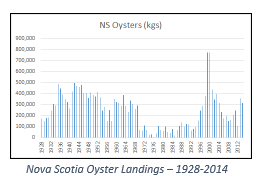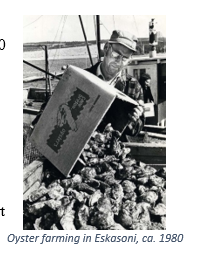IT MUST BE SOMETHING IN THE WATER: THE IMPACT OF THE OYSTER PARASITE Haplosporidium nelsoni TO OYSTERS AND PEOPLE OF THE BRAS D’OR LAKE CAPE BRETON, NOVA SCOTIA AND THEIR COLLECTIVE EFFORTS FOR SURVIVAL
In 2001-02 the Bras d’Or Lake, Cape Breton, Nova Scotia oyster industry suffered catastrophic losses from the lethal oyster parasite, Haplosporidium nelsoni (MSX). This parasite has caused devastating losses along the United States eastern seaboard for decades and oyster populations are slow to recover. The presence of H. nelsoni in the Bras d’Or Lake caused an 80% reduction in oyster production for Nova Scotia. Over the past years, there have been small-scale research projects in the Bras d’Or Lake focused on possible measures for mitigation strategies and gaining a better understanding of the parasite. Collectively, these projects provided insight into rebuilding this industry. In 2018, funding was obtained for a 3-year project involving oyster leaseholders from across the Bras d’Or Lake to monitor growth, mortality, and disease assessment. This industry-focused project utilizes suspension culture technology in various locations throughout the Bras d’Or Lake while collecting information about the parasite, host, and environmental parameters to determine if environmental conditions can be used to mitigate losses from the parasite.
A fundamental aspect of this research effort is the perseverance and cooperation of oyster leaseholders from across the Bras d’Or Lake. Many are from families that have grown oysters for generations. Their collective passion for this animal, industry, and Island has lead to new initiatives and energy to revive this industry. Despite almost 20 years of loss, these champions of the Bras d’Or Lake continue to recognize the value oysters play historically, ecologically, economically, and culturally. Their relationship to oysters can only be described using their own words, so we will share some of their stories of survival.
The final part of the presentation will describe the science project itself in some detail, and will emphasize that a project of this scale and complexity could not have been undertaken without the support and commitment of the individuals who make up this industry live on this island, and have such a strong connection to the oyster.

